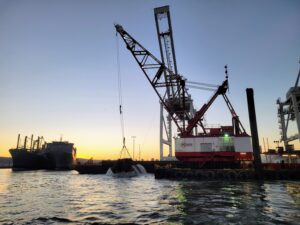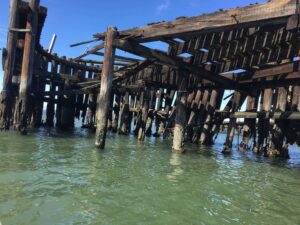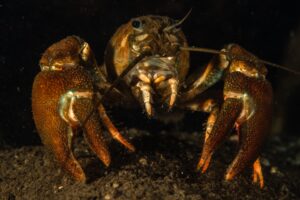The San Francisco Bay Model is running wet again, now that the dust has settled on a nearly 2-year renovation project.
The scale replica of the bay and Sacramento-San Joaquin River delta system has been largely out of the public eye — and dry — as construction crews upgraded the building and installed new exhibits and solar panels. Now, the U.S. Army Corps of Engineers, which runs the 1.5 acre model on a sea-front building in Sausalito, is welcoming visitors again, starting with a grand re-opening celebration on Saturday.
“Most people think of a model and they think a model train, or a model car – something that you can have on your coffee table or something,” said Chris Gallagher, Park Manager at the Bay Model. “Just the sheer vastness of it — people are fascinated by that.”
The model is indeed massive — 320-feet long by 400-feet wide — and underscores the true size of the San Francisco Bay, which covers 1,600 square miles from the Pacific Ocean to the Sacramento Delta. Compared to the model, the bay’s water is a hundred times deeper, distances are a thousand times larger, and the bay’s water is a million times greater. Looking out at the water near the miniature Bay Bridge, an hour in real time passes every thirty-six seconds in the model. As tides come and go, a day passes in just under fifteen minutes.
The upgrades were made possible by a $15.5 million federal stimulus grant. They include nearly 2,500 solar panels to power the 145,000 square-foot building and neighboring dock, seismic upgrades, spruced up facilities, and new fish tanks filled with starfish and rainbow trout.
“It’s not like walking into a newly renovated house with all new furniture,” said Gallagher. “A lot of the work is underneath the model. We got a lot of major renovations done that we probably won’t be able to do again for a long time, because our budget just gets cut and cut and cut.”
The Army Corps began building the model in the late 1950s in response to proposals to dam sections of the bay as freshwater reservoirs. The Corps built in features that would affect water flow into the bay, such as shipping channels, rivers, sloughs, canals in the Delta, piers, wharfs, and bridges.
Scientists using the model soon realized that the bay was a mere 12 to 18 feet deep in sections and would dry up faster than it would fill with fresh water. In the late 1960s, the model expanded to include the Suisun Bay and the Delta, and scientists and engineers tested the effects of levee failures, dredging, and oil spills. The model’s usefulness as a scientific research tool ended in 2000 as computers took its place.
Since then, the bay model has been kept open as a unique educational tool. Gallagher said visitors come to realize that the San Francisco Bay is more than just Alcatraz and Angel islands.
“It stretches all the way to the South bay, all the way to Stockton and Sacramento,” she said. “People don’t tend to see it that way until they can view it all in one place. You can really see the interconnectedness of the bay. What you do in one part of the bay really does affect what happens in another area of it. It’s not as isolated as you think.”
The grand re-opening celebration will be held this Saturday, February 25th from 11am-4pm at the Bay Model Visitor Center in Sausalito. The ceremony will be held at 2pm.

.jpg)



